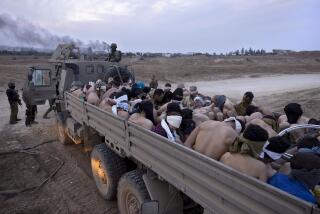‘Unimaginable’: Doctors overwhelmed at Nepalese trauma center

- Share via
Reporting from Katmandu, Nepal — Ronisa Tamang blinks her purple, swollen eyes at the request of a doctor, and is able to lift her left hand in a weak motion, but not her right. She breathes in erratic, shaky bursts.
A team of doctors sigh in relief when the girl, who is 10, is able to swallow small sips of water.
Ronisa, a robust-looking girl with a tangle of wavy dark hair, was rescued Tuesday from under the rubble of a small house in the rural region of Sindhupalchowk and flown 40 miles to Birendra Military Hospital in Katmandu. There, she was diagnosed with skull fractures; there is concern that she may have brain damage.
She faces a difficult path.
“No one else was found alive inside of her family’s home,” said Dr. Manoj Koirala, 33, who is among the medical professionals caring for her. “She is just a little girl, and she is all alone here right now, all by herself. We’re doing everything we can to keep her safe.”
Ronisa is among thousands of patients who have entered a makeshift triage center at Birendra since Saturday’s earthquake devastated Nepal. Here, doctors like Koirala have stayed up as long as 48 hours straight, making lightning-quick decisions about what people severely in the earthquake need, and how best to provide it.
The work is physically demanding and emotionally draining.
There is little time for meals. The doctors and military personnel stationed here eat biscuits and sip tea or water almost unconsciously, then charge back into action. When they do sleep, they do it in vacant hallways or on the grass outside for a few hours at a time.
Koirala estimates that at least 450 people have died in triage while he’s been on duty.
He’s trying to make sure that Ronisa will not be added to that list.
“Right now we’re trying to decide if she needs to see to a neurosurgeon,” Koirala said. “It will be a very difficult procedure; we will have to drain blood from the little girl’s brain.”
For the doctors and technicians at Birendra, the tent-shaking sound of an approaching HAL Rudra Indian army helicopter means that more patients are about to reach the triage center. The copters land in an open green field beside the hospital, and as they arrive, Nepalese army personnel wait in formation for the blades to stop spinning, squatting in the thick grass.
Someone from the troop gives a signal, and the soldiers scurry to the craft and start carrying the injured across a dirt road and into tents where the triage center was moved late Saturday. The helicopter that brought Ronisa carried 10 patients, all in various stages of physical stress.
Another girl Ronisa’s age had severe facial fractures, and blood caked across her nose and cheeks. When she was taken from the helicopter, a soldier shrugged off the stretcher and carried her across the field on his shoulder.
Common injuries include broken bones, internal bleeding, and limbs so mangled they require amputation.
The military personnel of at least three countries – India, Israel and Nepal – are collaborating in the rescue effort at Birendra, one of the largest hospitals in Nepal. The Israelis, with about 260 personnel, began establishing a field hospital out of tents Monday night on the opposite side of the heliport from Birendra.
“We’re collaborating with the Nepalese as best as we can,” said Dr. Tarif Bader, a colonel in the Israel Defense Forces and commander of its delegation. “Many parts of this hospital were completely destroyed during the earthquake, so we are hoping to offer additional equipment, as well as specialists who work in more specific medical fields.”
The Nepalese officer in charge of Birendra, Col. Bhai Krishna Khatri, 53, said he was at home watching television with his family in Katmandu when he felt “the world start shaking.” He waited 15 minutes for a sense of peace to settle in, then drove straight to the hospital.
When he arrived, he said, he found that many walls were cracked and immediately began making calls to set up the series of tents that now serve as Birendra’s main triage center.
“Never in my years of service have I ever seen such a horrific tragedy,” Khatri said. “The entire thing has been so sad. It’s unimaginable to me.”
Hayden is a special correspondent
More to Read
Sign up for Essential California
The most important California stories and recommendations in your inbox every morning.
You may occasionally receive promotional content from the Los Angeles Times.












